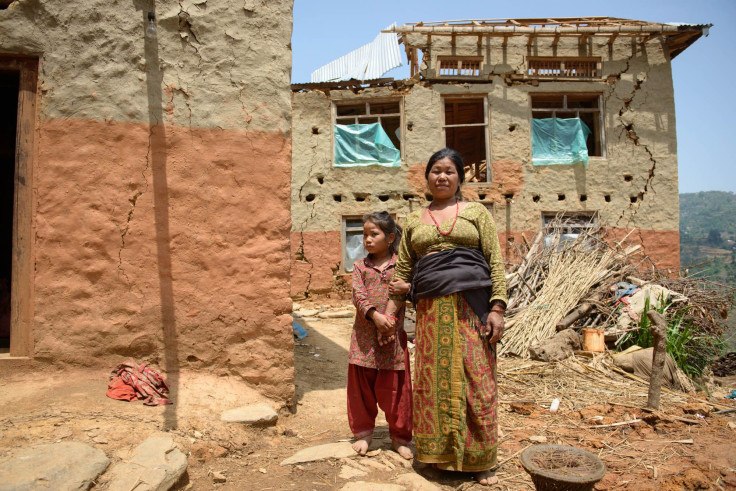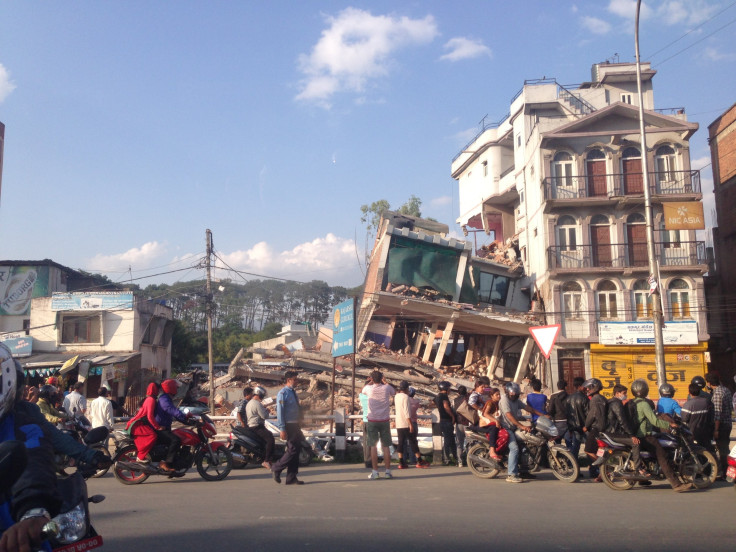Nepal Earthquake 2015: After Second Disaster, Aid Workers Race To Provide Shelter For Locals Ahead Of Monsoon Season

Aid worker Christy Delafield surveyed the flattened homes and unstable buildings threatening to topple at any moment as she and Nepali locals toured Tuesday a rural village in Kavre District, where devastation from the April 25 earthquake still stretched into the distance. Amid the destruction, children in the village were refusing to eat or sleep.
Suddenly, the ground beneath them shook, structures wobbled, trees shivered and the children screamed. The mothers yelled in Nepalese as they huddled with the aid workers on the ground, away from the buildings. A structure near them collapsed from the inside out and plumes of dust curled around them. Another mammoth earthquake had hammered the Himalayan country, less than three weeks after a magnitude-7.8 killed more than 8,000 people.
“Your heart’s racing and your legs feel wobbly,” said Delafield, a senior communications officer for Mercy Corps, a global aid agency based in Portland, Oregon. “It’s just the first time that I really understood what everyone’s been saying to me about how scared they’ve been, how traumatizing each subsequent shock is. They’re reliving it.”

For more than two weeks, Nepal residents have lived in fear that the earth beneath them would once again shake after a mighty earthquake hit west of Kathmandu last month. Their fears were realized Tuesday when a magnitude-7.3 quake hit east of the capital city, spreading devastation, claiming lives and hindering relief efforts across the South Asian country. Locals and aid workers said they now must start over in some areas to provide basic shelter against a racing clock as Nepal’s monsoon season nears.
“We’re really concerned. The clock is ticking,” Delafield said in a phone interview Tuesday.
In recent days, with recovery efforts underway, some Nepal residents began to sleep indoors again, children returned to school, the international airport in Kathmandu reopened and locals started salvaging materials from the rubble for temporary structures. But after Tuesday's earthquake, buildings that had barely held during the last quake crumbled and aid groups said there were no structures left standing in some areas.
Poorer communities have beeen hit hardest by the disaster because they can’t afford to build permanent concrete structures, which fare best during quakes and in the rain. The recent earthquakes have also loosened much of Nepal’s landscape, raising concerns among residents and aid groups that the country will suffer from landslides when the rains come in June. Many locals who can’t afford to rebuild homes will live outside under a sheet of grooved metal held up by bamboo frames for the next few months until the monsoon season ends, aid workers said.
“They leak a bit, they’re not great. When you’re inside and it’s raining, the sound is deafening,” Delafield said. “But it’s a roof over your head and it’s keeping your clothes dry.”

Tuesday’s quake, which killed and injured scores of people, also destroyed food stores and clean water supplies. Roads that were already in poor condition are now impassable, making it difficult to deliver aid relief to Nepal residents where the latest quake was centered. The only international airport in Nepal was shut down again, which means aid shipments cannot land. A limited number of helicopters were available to distribute supplies to remote regions in the mountains.
“Already, access was one of our biggest challenges and we’re looking at worse access now,” said Lucy Beck, an emergency response specialist with CARE, an international aid group based in Atlanta. Beck, who arrived after the April 25 quake, was meeting with team members in Kathmandu on the fourth floor of a building Tuesday when the structure began to sway. “It’s even more urgent. The challenges have increased," she said during a phone interview.
Locals have already returned to the fields to harvest potatoes and plant wheat crop ahead of the monsoon season that begins in June and ends in September. But their concern more than anything is shelter, aid workers said. “Tarps are the number one requested material, more than food,” Delafield said.
© Copyright IBTimes 2024. All rights reserved.





















